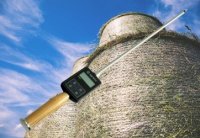Product Review: EC-TN100-IR NTU Turbidimeter

The Instrument Choice Team of Scientists regularly reviews new and popular products, so when searching for the perfect scientific instrument for your application, you can make more informed decisions.
This edition assesses the EC-TN100-IR NTU Turbidimeter, a practical, popular and affordable turbidity meter suitable for an extensive range of water quality monitoring applications.
What is a Turbidimeter?
Turbidimeters (also “turbidity meters”) are water quality analysis tools that measure the “cloudiness” of water samples due to the presence of suspended particles. The higher the level of turbidity, the greater number of particles in the water sample.
NTU turbidimeters
NTU stands for Nephelometric Turbidity Unit, which is a standard and commonly used unit of turbidity measurement. (Note: NTU is equivalent to Formazine Turbidity Unit (FTU).) NTU instruments measure scattered light from a water sample at a 90-degree angle from the incident light.
This technology combines a light source, lens, sensor, processor and LCD screen to measure and display readings. You place your sample between the light source and a sensor. Irrespective of the level of suspended particles present, the light will pass through your sample and arrive at the sensor at a 90° angle. Internal processors calculate the amount of light scattering and compare results against known standards on a calibration curve. Your resulting turbidity measurement will then appear on the LCD. This process may seem complex, but it all happens within a matter of seconds.
|
SCIENTIST’S TIP: The light source deployed by the turbidity meter you choose is a critical decision. Each industry adopts a different standard. Turbidity meters will use either infrared light at 860nm (ISO 7027) or the visible light spectrum 600-400nm (US EPA 180.1). |
Introducing the EC-TN100-IR NTU Turbidimeter
The EC-TN100-IR NTU Turbidimeter is a microprocessor-based, waterproof, fast, and accurate turbidity meter. This device is IP67 rated water and dustproof – and what’s more, it floats on water, which means it is superbly suited to the rigours of fieldwork.
The EC-TN100-IR comes as a kit with everything you’ll require for accurate turbidity measurements. The kit includes:
- The EC-TN100-IR NTU Turbidimeter
- A set of 4 calibration standards (800, 100, 20.0 & 0.02 NTU)
- Seven sample vials
- A lint-free cloth
- Silicone oil
- Batteries
- Comprehensive instruction manual; and
- Hard carrying case.
The Impressive Features of the EC-TN100-IR NTU Turbidimeter
- Light Source: Infrared-emitting diode (850nm wavelength) offers a consistent light source and meets the criteria specified in ISO 7027 and DIN 27027 standards.
- Microprocessor-Based: The meter has an internal microprocessor that ensures quick measurements and unprecedented full-range accuracy.
- Water and Dustproof Housing: Your turbidity meter will excel in wet conditions due to ABS plastic casing that is easy to clean and maintain, an IP67 waterproof rating and the units' ability to float on water.
- Auto-Ranging: The meter automatically calculates and, within seconds, displays on its LCD a sample’s average turbidity level and range.
- Simple Calibration: Calibration is straightforward. Users need only insert a standard and press the “CAL” button. The device prompts users when the next calibration standard is required.
- LCD Screen: Results are easy to read on the extra-large LCD screen. The screen also displays units of measure and gives message codes to help simplify the meter’s operation.
- Advanced Power Management: Users can enjoy up to 1200 sample measurements on a single set of batteries.
- Auto-Off: The unit automatically switches off 20 minutes after the last button press to conserve battery life.
- All-in-One Kit: The EC-TN100-IR NTU Turbidimeter comes with all the tools required to start making fast, accurate and reliable turbidity measurements for almost any application.
EC-TN100-IR NTU Turbidimeter Specifications
EC-TN100-IR Specifications |
|
|
Principle of Operation |
Nephelometric non-ratio (conformance to |
|
Turbidity Range |
0 to 2000 NTU |
|
Resolution |
0.01 NTU (0 to 19.9 NTU) |
|
Accuracy |
± 2% of reading ± 1 LSD for 0 to 500 NTU |
|
Repeatability |
± 1% of reading or ± 0.01 NTU |
|
Sample Volume |
10mL |
|
Calibration Points |
4 points (automatic) |
|
Calibration Standards |
0.02 NTU; 20.0 NTU; 100 NTU; 800 NTU |
|
Response Time |
< 6 seconds for full step change |
|
Standardization |
EPA-approved polymer-based primary standards |
|
Light Source |
Infrared-emitting diode (850nm wavelength) |
|
Light Source Life |
> 1,000,000 tests |
|
Operating and Sample Temperature Range |
0 to 50 °C |
|
Enclosure Type & Rating |
ABS plastic & IP67 rated |
|
Power Requirements |
4 x 1.4V batteries, > 200 hours |
|
Dimensions |
Meter: 15.5 x 6.8 x 4.6 cm; Boxed: 35.5 x 16.5 x 10.5 cm |
|
Weight |
Meter: 200 g; Boxed: 1,160 g |
EC-TN100-IR NTU Turbidimeter Applications
The portability and ease of use of the EC-TN100-IR NTU Turbidimeter make it a prime candidate for applications such as:
- Monitoring of drinking water
- Beverage production
- Checking swimming pools
- Aquariums
- Aquaculture; and
- Environmental applications, including research and education purposes.
Conclusion
What do our scientists conclude about the EC-TN100-IR NTU Turbidimeter?
“Rugged and light-weight, suitable for fieldwork yet accurate enough for laboratory use, the EC-TN100-IR NTU Turbidimeter is a first choice turbidimeter for any water quality monitoring application.”
Want more information on any of the products mentioned above? Speak with an Instrument Choice Scientist! We're here to help! Call 1300 737 871 or email [email protected].

Also interesting
The consequences of harvesting, baling and storing hay with incorrect moisture levels are many and costly! Monitoring the moisture content of hay with a hay moisture tester is a quick and easy way to help prevent crop, revenue, and property loss.
There are different methods for measuring moisture with a hay moisture tester, so your Instrument Choice Scientists decided to check out the best methods. Here’s what they found.
Read on for the best ways to manage forage moisture content to create a safe, stable, and valuable product.

Emissions from vehicles, smoke, dust, fuel burning and industry are some of the many causes of outdoor pollution (also referred to as ambient air pollution). Many pollutants within emissions are harmful to human health when they occur in high concentrations.
This article discusses some major outdoor air pollutants and how you can monitor them.

